Mandevilla: Grow & Care for Rocktrumpet
Written by Iris
Aug 23 2021
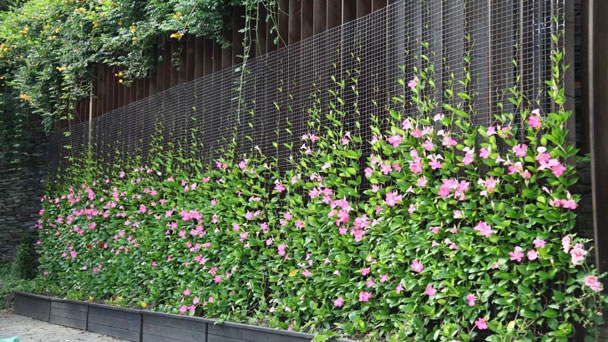
Mandevilla (Rocktrumpet) is a new type of vine, native to tropical America, and is a perennial evergreen plant. When the fragrance vine blooms, the bursts of tangy fragrance make people feel relaxed and happy.
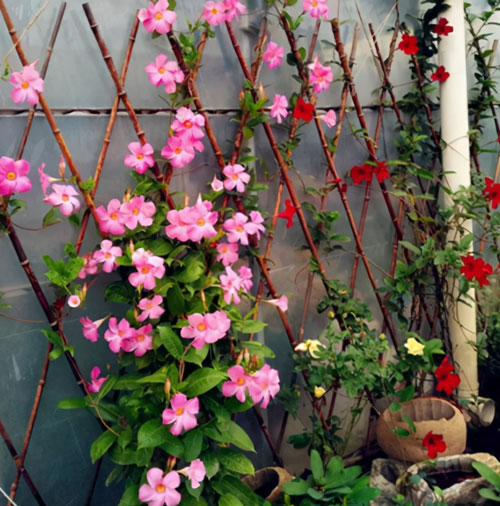
Gardeners must ensure that they don't add any additional fertilizer to the plant for at least 3 to 4-months after planting. The addition of fertilizer on top of the nutrients already in the soil results in burning the root system.
After the Mandevilla reaches 6 to 12-months old, the gardener can fertilize cautiously, using a slow-release fertilizer product diluted with plenty of water. Alternately, providing the plant with a top dressing of organic compost may give the plant the nutrition it needs to grow and flower.
Pruning
If you're growing your mandevilla vine in a pot that you’ll bring indoors in the winter, prune back your plant in early fall to a ten inch stem, then store it in a sheltered spot where the temperatures won’t drop below 55 degrees Fahrenheit. In the spring, you can trim the ends off your soil-grown mandevillas to encourage bushy growth and to keep the vine manageable.
Mandevilla vines are prone to botrytis blight, which is also called gray mold, and may cause the leaves to wilt or turn brown. Neem oil can help address this disease. Crown gall is an easily visible swelling on branches or at the base of the plant, which unfortunately can't be treated. If your plant gets crown gall, it should be destroyed and not composted. Related article - 9 tips about Mandevilla Care.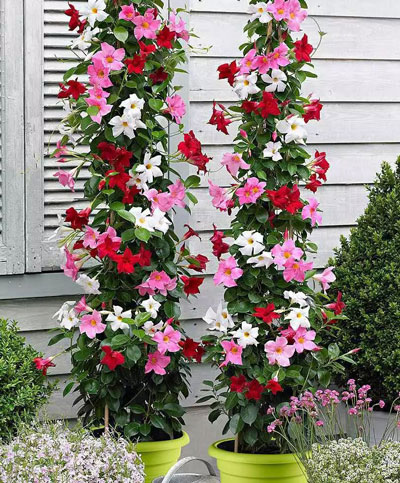
Mandevilla sanderi: Commonly known as Brazilian jasmine, this species is fast-growing and can reach up to 15 feet tall with twining, woody stems and large pink-red blooms.
Mandevilla boliviensis: Also known as white mandevilla, this species is notable for its white blooms; it can grow between 3 and 10 feet tall with a 3- to 6-foot spread.
Mandevilla laxa: Known commonly as Chilean jasmine, this species produces masses of heavily scented white flowers and can reach up to 20 feet tall.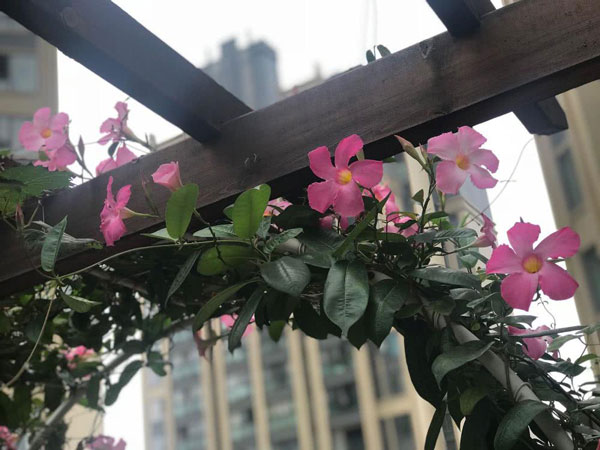
About three weeks before 40-degree nighttime temperatures are predicted, feed mandevilla a high-phosphorous liquid fertilizer, such as 10-56-14, at half strength. (The middle number represents phosphorous, which promotes healthy roots.)
When temperatures start to drop to about 50 degrees F at night but still in the 60's during the day, scale back on watering.
As temperatures dip regularly below 50 degrees F at night but before it freezes, cut the mandevilla vine back to about 12 inches above the soil line.
Wash mandevilla foliage thoroughly with mild dish soap and rinse with water to remove any insects, or spray with insecticidal soap.
Move it into a cool basement, garage or crawl space that maintains a winter temperature above freezing — around 50 to 60 degrees F is ideal.
Because it will go dormant, supplemental light isn't necessary.
Water lightly every 5 to 6 weeks so the soil stays on the dry side, but don't fertilize.
In early spring the plant will start to form new shoots. Keeping it indoors, move it to a sunny window and pinch the growing tips to form a bushier vine.
Wait until all chance of frost has passed and nighttime temps stay above 50 degrees F before moving it outside.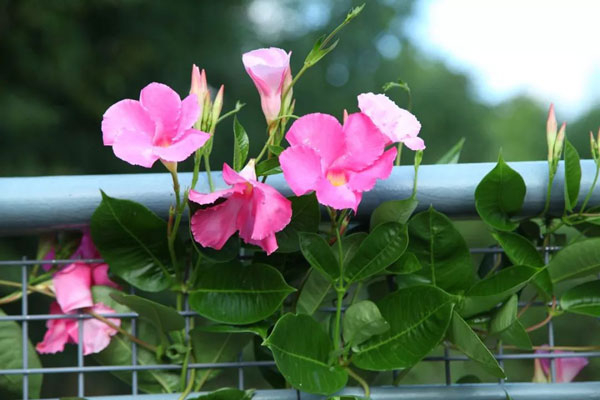
Symptoms of Poisoning
If ingested, symptoms could be similar to that of other mildly toxic plants such as upset stomach, nausea, vomiting, and diarrhea. Symptoms from skin contact with the sap may include redness, pain, itching, and sores.Most cases are mild, but it’s still important to contact a medical professional if you suspect poisoning.
How to Grow Mandevilla (Rocktrumpet)How to Care for Mandevilla (Rocktrumpet)Varieties of Mandevilla (Rocktrumpet)Mandevilla (Rocktrumpet) FAQ
How to Grow Mandevilla (Rocktrumpet)
The mandevilla plant can be propagated using two main techniques, namely cuttings and planting seeds.Steps for Mandevilla (Rocktrumpet)Propagation with Seeds
Cultivating mandevilla from seed is simple. Growth is most often achieved using fresh seeds extracted from dried out pods. It’s recommended that you soak the dandelion-like seeds in water for 12 hours before planting.Plant the seeds in a shallow hole in well-draining soil. The soil needs to remain moist and warm during this time. They should germinate within a month.Steps for Mandevilla (Rocktrumpet) Propagation with Stem Cuttings
Propagating mandevilla from cuttings is a fairly easy process too. Take cuttings during the spring for best results. When selecting a piece to cut, ensure it’s either a side shoot or tip around 7.5 centimetres long. Keep the top two leaves and remove the rest. Place the cuttings in a mix of sand and peat, placing it in a warm, humid, shady, and moist area. Once the roots have developed you can place the plant in its official spot.
How to Care for Mandevilla (Rocktrumpet)
Light Care
The foliage of the Mandevilla is certainly attractive, but the showy flowers are the real show-stopper. To be sure of ample, healthy blooms, you must place your Mandevilla in an area where it can stay warm and get plenty of full sunlight or indirect bright light. You’ll find the Mandevilla plant growing in full bright sun in south Florida, but they seem to do better with a light bit of shading. The morning sun is ideal. A high shade setting that receives good sun in the morning and/or afternoon but sheltered at high noon is ideal.Soil Care
These flowers need sandy, well-draining soil with plenty of organic material mixed in. A good potting mix is a combination of peat moss, builder's sand, and leaf mold. A slightly acidic to neutral soil pH is best, though they also can tolerate slightly alkaline soil.Water Care
Mandevilla prefers regular amounts of water, whether indoors or out. Water your plant weekly with a deep soaking until you see moist soil, or water draining from container plants. Keep the soil moist, but not dripping wet, and make sure it's well-draining; cut back on watering during the winter when growth slows down, letting the soil dry out more between waterings. If it takes longer than 30 seconds for water to soak into the soil, consider repotting or replanting the plant. Add sand or perlite to soil to help with draining, and make sure plant containers have good drainage holes.Temperature and Humidity Care
These plants require warm temperatures and high humidity. Temperatures should be at least 60 degrees Fahrenheit during the day and 50 degrees Fahrenheit at night for mandevilla to be planted outside. If you live in a dry climate, regularly misting your plants will help to keep humidity levels up.Fertilizer Care
When buying your Mandevilla at a garden center or nursery, the plant will likely have slow-releasing fertilizer mixed into the soil. The nutrients in the soil should last your Mandevilla a few months, but after it runs out, the gardener will need to add some more fertilizer to keep the plant growing.Gardeners must ensure that they don't add any additional fertilizer to the plant for at least 3 to 4-months after planting. The addition of fertilizer on top of the nutrients already in the soil results in burning the root system.
After the Mandevilla reaches 6 to 12-months old, the gardener can fertilize cautiously, using a slow-release fertilizer product diluted with plenty of water. Alternately, providing the plant with a top dressing of organic compost may give the plant the nutrition it needs to grow and flower.
Pruning
If you're growing your mandevilla vine in a pot that you’ll bring indoors in the winter, prune back your plant in early fall to a ten inch stem, then store it in a sheltered spot where the temperatures won’t drop below 55 degrees Fahrenheit. In the spring, you can trim the ends off your soil-grown mandevillas to encourage bushy growth and to keep the vine manageable.
Pests and Diseases Care
Insects that are attracted to mandevilla vines include spider mites, scale, white flies, and mealybugs. Control these pests by cutting off infected stems or leaves, or clean your plant with a strong spray of water, insecticidal soap, or neem oil.Mandevilla vines are prone to botrytis blight, which is also called gray mold, and may cause the leaves to wilt or turn brown. Neem oil can help address this disease. Crown gall is an easily visible swelling on branches or at the base of the plant, which unfortunately can't be treated. If your plant gets crown gall, it should be destroyed and not composted. Related article - 9 tips about Mandevilla Care.

Varieties of Mandevilla (Rocktrumpet)
There are more than 100 species within the Mandevilla genus, including:Mandevilla sanderi: Commonly known as Brazilian jasmine, this species is fast-growing and can reach up to 15 feet tall with twining, woody stems and large pink-red blooms.
Mandevilla boliviensis: Also known as white mandevilla, this species is notable for its white blooms; it can grow between 3 and 10 feet tall with a 3- to 6-foot spread.
Mandevilla laxa: Known commonly as Chilean jasmine, this species produces masses of heavily scented white flowers and can reach up to 20 feet tall.

Mandevilla (Rocktrumpet) FAQ
How to overwinter mandevilla?
Save money next year by brin ging a tender mandevilla plant indoors this winter instead of letting it die. Here's how to overwinter a mandevilla:About three weeks before 40-degree nighttime temperatures are predicted, feed mandevilla a high-phosphorous liquid fertilizer, such as 10-56-14, at half strength. (The middle number represents phosphorous, which promotes healthy roots.)
When temperatures start to drop to about 50 degrees F at night but still in the 60's during the day, scale back on watering.
As temperatures dip regularly below 50 degrees F at night but before it freezes, cut the mandevilla vine back to about 12 inches above the soil line.
Wash mandevilla foliage thoroughly with mild dish soap and rinse with water to remove any insects, or spray with insecticidal soap.
Move it into a cool basement, garage or crawl space that maintains a winter temperature above freezing — around 50 to 60 degrees F is ideal.
Because it will go dormant, supplemental light isn't necessary.
Water lightly every 5 to 6 weeks so the soil stays on the dry side, but don't fertilize.
In early spring the plant will start to form new shoots. Keeping it indoors, move it to a sunny window and pinch the growing tips to form a bushier vine.
Wait until all chance of frost has passed and nighttime temps stay above 50 degrees F before moving it outside.

Is Mandevilla Toxic?
In some cases, parts of this plant could be toxic when ingested. Milky sap from the plants may cause skin irritation, as well as allergic reactions in those who are sensitive to the mandevilla species.Symptoms of Poisoning
If ingested, symptoms could be similar to that of other mildly toxic plants such as upset stomach, nausea, vomiting, and diarrhea. Symptoms from skin contact with the sap may include redness, pain, itching, and sores.Most cases are mild, but it’s still important to contact a medical professional if you suspect poisoning.
Latest Updated
- Benefits of Bugleweed - 7 Science-backed Health Benefits
- Bugleweed Dangers & Side Effects - Is It Poisonous?
- How to Plant Evergreen Trees - What You Should Know
- When to Plant Evergreens - Grow Guide for Evergreen Trees
- 12 Wonderful Evergreen Shrubs for Your Garden
- 12 Popular Evergreen Plants with Pictures for Beginners
- When And How To Prune A Lilac Bush Like a Pro
- How to Grow & Care for Lilac Vine (Hardenbergia Violacea)
- Japanese Lilac Tree (Syringa Reticulata) Care & Propagation Guide
- Shumard Oak Pros and Cons - What to Know
Popular Articles
- Winter maintenance of Antirrhinum Majus
- How to Grow Terminalia Mantaly Tree
- How to Grow and Care for Crossostephium Chinense
- How to grow Antirrhinum Majus in spring
- Peristeria Elata (Dove Orchid) Profile: Info & Care Guide
- Underwatered Snake Plant (Sansevieria Trifasciata) - Signs And How To Fix
- How to Care for Brazilian Jasmine Plant (Mandevilla Sanderi)
- How to Grow & Care for Graptopetalum Purple Delight in Summer
- Rosa Chinensis (China Rose): Plant Growing & Care Tips
- How to Care for Baby Sun Rose (Aptenia Cordifolia)